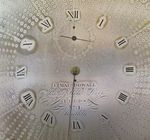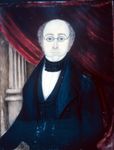Geoff Sykes Harrison and Grimthorpe - the missing link - Holy ...
←
→
Page content transcription
If your browser does not render page correctly, please read the page content below
Geoff Sykes
Harrison and Grimthorpe – the missing link
Antiquarian Horology, Volume 42, No. 1 (March 2021), pp. 103–107
The AHS (Antiquarian Horological Society) is a charity and learned society formed in 1953 . It exists to encourage
the study of all matters relating to the art and history of time measurement, to foster and disseminate original
research, and to encourage the preservation of examples of the horological and allied arts.
To achieve its aims the AHS holds meetings and publishes books as well as its quarterly peer-reviewed journal
Antiquarian Horology. The journal, printed to the highest standards fully in colour, contains a variety of articles
and notes, the society’s programme, news, letters and high-quality advertising (both trade and private). A complete
collection of the journals is an invaluable store of horological information, the articles covering diverse subjects
including many makers from the famous to the obscure. The entire back catalogue of Antiquarian Horology,
every single page published since 1953 (except the most recent volumes), is available on-line, fully searchable.
It is accessible for AHS members only.
For more information visit www.ahsoc.org
Volume 42, No. 1 (March 2021) contains the following
articles
Charles and Joseph MacDowall and their
helical clockwork, by Angus Bell and Kenneth Cobb
Technical Note: An examination of the MacDowalls’
NUMBER ONE VOLUME FORTY-TWO MARCH 2021
helix lever gearing, by Angus Bell and Kenneth Cobb
Horological tradesmen and a Victorian directory
scam – the Londoniad, by D. J. Bryden
French carriage clocks and late nineteenth-century
decorative arts: Artistry in an era of art reform,
by Larry L. Fabian
John Kaye of Liverpool – Can his clock predict the
time and height of high water at Liverpool?,
by Steve and Darlah Thomas
‘A process superior to any previously known’. The
introduction of electro-gilding for watches in mid
nineteenth-century England,
by Michael Edidin
Harrison and Grimthorpe – the missing link,
by Geoff Sykes
Front cover: Detail of the dial of Joseph MacDowall’s
regulator at the Yorkshire Museum.
1MARCH 2021
Harrison and Grimthorpe—the missing link
Geoff Sykes*
This article discusses a flatbed turret clock in the parish church of Great Langdale
in the English Lake District, installed in 1858 by James Harrison of Hull. A recently
discovered letter provides proof that the clock was closely based on the design of a
clock by E. B. Denison, Lord Grimthorpe.
Fig. 1. The Langdale clock by James Harrison, 1858.
The James Harrison of Hull flatbed The present parish church (Holy Trinity
clock Langdale) was built in 1858 to replace the
The parish church of Great Langdale in the former chapel which had become too small
central Lake District contains a remarkable for the expanding population. The village in
turret clock (Fig. 1). It was made by James Langdale is still called Chapel Stile, even
Harrison of Hull, and it has been thought for though the chapel was demolished in 1858.
some time that there must be a connection to The church was paid for by two wealthy
Lord Grimthorpe. Following the recent benefactors — John Robinson, a local business
retirement of the vicar, Eric Rigg the owner, and Edward Wheatley-Balme who
Churchwarden went through the church files lived partly on an estate he acquired in
and discovered the ‘missing link’ which had Langdale, and partly in Yorkshire where his
been lying there unnoticed since the clock family business, Henry Wheatley & Sons of
was installed in 1858. Mirfield, owned woollen mills.
*Geoff Sykes (GeoffSykes@outlook.com) has been on the Committee of the Turret Clock Group from 2005
until 2020, first as treasurer and from 2011 onward as chairman.
103ANTIQUARIAN HOROLOGY
Fig. 2. James Harrison of Hull (1792–1875) (Hull
Museums).
There is no name on the flatbed movement,
and the only information on its maker came
from a booklet written in 1958 to mark the Fig. 3. E. B. Denison, Lord Grimthorpe (1816–1905).
building’s centenary by Hugh Ellison, the son
of the then vicar. He says: ‘James Harrison of • Unusual shape of tooth form
Hull completed the mechanism in 1858, but • Unusual shape of pinion leaves
refused to install it in the tower until he had • Peculiar concave shape to end of arbors
tested it for five years in all conditions of heat and centres left in
and cold’. Nothing is known of these tests. • Harrison’s flirt release striking
• Peculiar long clicks
The origins of the clock • Dog clutch for setting dial
About twenty-five years ago, Chris McKay
visited the church on being told that it Chris also pointed out that he had seen
contained a flatbed turret clock by James another almost identical clock. He was
Harrison. Chris was doubtful about this, referring to the 1850 clock by Dent at Holy
because all known turret clocks by James Trinity Church Meanwood, Leeds. An
Harrison are square frame or ‘plate and engraving of it (Fig. 4) was featured as the
spacer’ clocks, and it was thought Harrrison frontispiece of the first edition (1850) of A
never made a flatbed. This is evident from Rudimentary Treatise on Clock and Watch
Chris’s comprehensive study of James Making by E. B. Denison, Lord Grimthorpe.
Harrison’s turret clocks: Longitude’s Legacy The book was very successful and ran through
– James Harrison of Hull 1792–1875, Turret eight editions, the last in 1903, and all the
Clock Maker, the last of the Harrison later editions had the Great Westminster
clockmakers (2015), which does include the Clock (‘Big Ben’) as the frontispiece instead of
Langdale flatbed clock. Chris concluded that the Meanwood clock.
the clock is undoubtedly by James Harrison of The engraving in the book is not a very
Hull because he identified six features which accurate picture of the Meanwood clock, and
are found on James Harrison turret clocks: the Langdale clock is much closer to the
104MARCH 2021
Fig. 4. Meanwood Church clock (1850). Frontispiece from the first edition of A Rudimentary Treatise
on Clock and Watch Making by E. B. Denison. The pendulum rod (‘P’) is not shown in full, both to save
space, and in order to show the tubular construction.
Fig. 5. The Meanwood clock by Dent, 1850.
105ANTIQUARIAN HOROLOGY
picture in the book than is the actual
Meanwood clock (Fig. 5). This may be because
Harrison never visited Meanwood, but worked
on the basis of the illustration in the book.
The Meanwood clock exhibits Dent
workmanship, but it was not very successful,
and it has been altered over the years,
including removal of the spring remontoire
and fly, whereas the Langdale clock has been
carefully preserved.
The discovery of the letter
It seemed clear that the Langdale clock was
closely based on Lord Grimthorpe’s Meanwood
design, but it was only very recently that the
‘missing link’ was finally discovered. It is a
letter dated 9 November 1858, written by
James Harrison to the benefactor paying for
the clock, Mr E. B. Wheatley Balme.
Transcription of the letter
Hull Nov. 9th 1858
Sir
The new clock at Langdale Church was
completed and put in motion last June its
management left to Mr Walker, Smith to J.
Robinson Esqr. it is made to the plan of E.
B. Denison Esqr. and is expected to excel
the usual method of Turret Clock Making.
The pendulum (which is the instrument
that measures time) is so accurately
adjusted in its compensation I think few if
any equal to it. The impulse or maintaining
power is given through the escapement and
is so constructed that any amount of recoil
may be given to it which is found to be
necessary. Near the bottom of case is a
small pointer used to ascertain the swing of
the pendulum.
On the other side I have given the bill of
the whole of my expense which will be
found correct.
I am Sir
Your obed[ien]t ser[van]t
Jas. Harrison
E. B. Wheatley Balme Esqr
To Jas. Harrison
A Turret Clock for Langdale Church
including attendance and putting up as per
agreement £150
Fig. 6. James Harrison’s letter front and back.
106MARCH 2021
The wording in the letter which says the then was — and 1858 when the Langdale
Langdale clock is ‘made to the plan of E. B. clock was installed. A possible explanation is
Denison Esqr. and is expected to excel the that Harrison, having never made a flatbed,
usual method of Turret Clock Making’ seems decided to start by making a copy of the
to be a way of saying it is closely based on the Meanwood clock, as shown in Lord
Meanwood clock. The Langdale clock has the Grimthorpe’s book, for his own research, and
key features of the Meanwood clock, including then experiment with it for five years. It
the spring remontoire with a large remontoire seems he found someone wealthy enough to
fly, and a tubular compensation pendulum pay £150 for it — Mr Wheatley Balme, who we
similar to that on ‘Big Ben’. think he knew because Mr Wheatley Balme
We still do not know anything of the ‘five lived part-time in an area of Yorkshire where
years of testing’ mentioned in the 1958 Harrison had installed turret clocks. This
booklet. However, there is an eight-year gap connection would explain why a clockmaker
between 1850 when the Meanwood clock was based 150 miles away in Hull came to install a
completed, and the book was published by remarkable turret clock in a remote corner of
Lord Grimthorpe — or E. B. Denison as he the Lake District.
107You can also read

























































